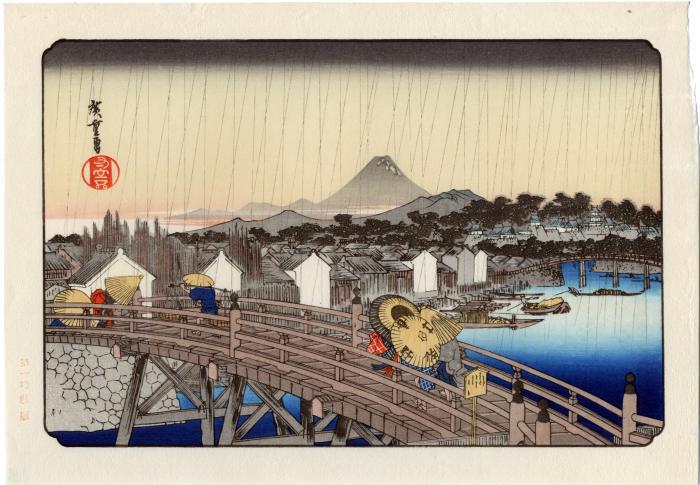Utagawa Hiroshige (歌川広重) (artist 1797 – 1858)
Shower on Nihonbashi (Nihonbashi no hakuu) from the series Famous Places in the Eastern Capital (Tōto meisho) - a modern reproduction
1830s
12.75 in x 8.875 in (Overall dimensions) Japanese woodblock print
Signed: Hiroshige ga (広重画)
Artist's seal: Ichiryūsai
Museum of Fine Arts, Boston - an original copy for comparison
Asian Art Museum, San Francisco - similar scene by Hiroshige but with snow
Ashmolean Museum - an original edition In the original print the publisher Sanoya Kihei has displayed his seal name, Sanoki (佐野喜), painted onto the top of the open yellow umbrella
****
In Hiroshige: An Exhibition of Woodblock Prints to Mark the 200th Anniversary of the Artist's Birth (p. 68) it says:
In his prints Hiroshige depicted the Nihon Bridge and its environs, sometimes rendering them from the same vantage point. In each of his works, however, the artist succeeded in evoking a different mood and a different poetic quality of forms and colours. Here we can see a bridge with pedestrians with umbrellas, the river with boats, and on the opposite bank a row of warehouses and the dark silhouettes of trees and hills. In the distance to the right, on the site of the present imperial palace, there rises the castle of the Tokugawa shoguns. On the horizon, above the streaks of white, slightly orange-tinted mists can be seen the silhouette of Mount Fuji. Across the entire plate run thin, light grey hatches of rain, toning down the clear-cut forms and colours.****
This is a twentieth century printing of this famous image by Hiroshige. The original first appeared in ca. 1834-35. Note that among other differences this modern copy does not carry the blue title cartouche in the upper right (東都名所 日本橋之白雨), outside of the image frame.
****
"Nihonbashi - "Bridge of Japan" - was the nation's most famous and important bridge during the Edo period (1600—1868). Designated by Shogun Tokugawa Ieyasu in 1603 as the hub of the nationwide highway network, the wooden structure's sixteen-foot (five-meter) span became both a destination and departure point for journeys to and from the new capital city. In those days, when travel routes doubled as “information highways” constantly traversed by messengers, news of all kinds arrived and spread from Nihonbashi.
The river under the bridge, the Nihonbashi-gawa, became the artery of the city's commerce. Wealthy merchants from Kyoto and Osaka opened their branches along the river to capitalize on Edo's booming economy. In time the riverside became the site of sophisticated business transactions. Meanwhile, steady employment in the fast-growing city attracted craftsmen and laborers from surrounding provinces, and entertainers of all genres rushed to delight their ever appreciative audiences.
A fish market opened on the bridge's northeastern end, initially to supply the large kitchen of Edo Castle. Later, with the shogun's permission, fishmongers sold remains of the official purveyance to the public. As the daily fresh catches from Edo Bay were so bountiful, the market grew rapidly, becoming one of the three biggest money-making centers of Edo, along with the Kabukiza theater and the Yoshiwara red-light district. High-spirited fishmongers with handsome demeanors and sharp speech were admired as the ideal of Edokko - the townspeople of Edo."
Quoted from: Tokyo: Exploring the City of the Shogun by Sumiko Enbutsu and Katsuhito Nakazato.
landscape prints (fūkeiga 風景画) (genre)
Historical - Social - Ephemera (genre)
Mount Fuji (富士山) (genre)
Nihonbashi (日本橋) (genre)
